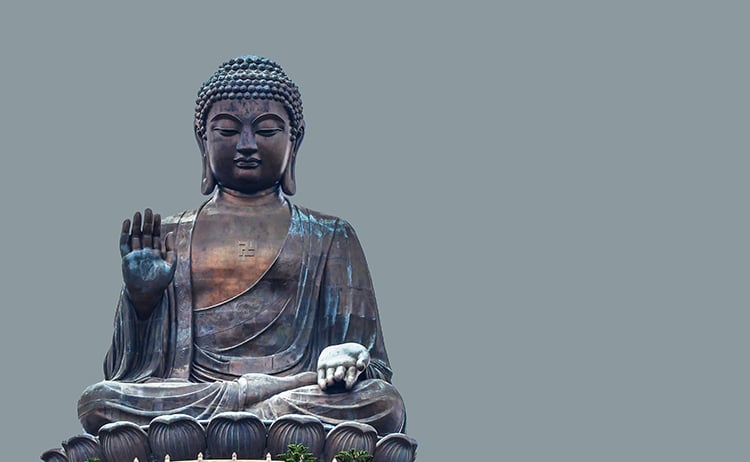Sacred Buddhist Scripture
Category: Buddhist Path | Recent Meditation Posts

Sacred Buddhist scripture includes written accounts of the Buddha’s teachings, teachings by his disciples, and commentaries on those teachings. The vast anthology spans many centuries, geographic regions and languages. Here we learn more about the most important sacred Buddhist scriptures.
- What were the earliest Buddhist texts?
- What is the Pali Canon?
- What is the Chinese Buddhist Canon?
- What is the Tibetan Buddhist Canon?
- Does Buddhism have a Bible?
- What Buddhist texts are in English?
- What are the best Buddha quotes?
Early Buddhist Texts
After the Buddha died, his teachings continued to be shared, passed orally from his students to others. The earliest known Buddhist manuscripts date back to at least 100 BCE. It appears these early texts were not meant to be shared in material form, but were used by monks to help them memorize the teachings. These teachings were then shared orally with the public, many of whom could not read.
Today, memorization is still a popular form of Buddhist study. Monks continue to memorize full texts, while lay practitioners have typically memorized a few brief sutras, prayers or poems for use in meditation.
The Pali Canon
The oldest Buddhist texts were written in the Pali language. The Pali Canon is organized into three baskets or Tripitaka in Pali. The first is the Vinaya Pitaka. These scriptures on Buddhist discipline describe the rules on ethical conduct that monks were to follow. The second is the Sutta Pitaka. This vast collection includes accounts of the Buddha’s earliest teachings after his enlightenment, such as how to meditate and the 4 noble truths. Texts in the Abhidhamma Pitaka provide analysis and commentary on the texts of the Sutta Pitaka.
The Buddhist scripture of the Pali Canon is central to Theravada Buddhism. Followers of this early form of Buddhism accept only the Pali Canon, and not later Mahayana scriptures, as sacred. The Pali Canon, however, is accepted by Mahayana Buddhists, who view these as foundational teachings. Pali Canon texts include the Kesamutti Sutta, in which the Buddha encouraged the practice of intelligent versus blind faith, and the Satipatthana Sutta, The Discourse on The Foundations of Mindfulness.
Mahayana Buddhism’s Sacred Texts
Mahayana Buddhism’s sacred texts are organized into the Chinese Buddhist Canon and the Tibetan Buddhist Canon. These categories, along with the Pali Canon, are just one way to organize Buddhist scripture. In practice, most Buddhist scripture is shared by many traditions.
The Chinese Buddhist Canon
The Chinese Buddhist Canon is the primary focus of East Asian Buddhist traditions. It includes texts that are commonly studied by all Mahayana Buddhists. The Lotus Sutra teaches that we all have Buddha nature and the potential for enlightenment. From the Prajñāpāramitā Sūtra, we get the Diamond Sutra and the Heart Sutra, a popular condensed version of the essence of the wisdom teachings.
The Tibetan Buddhist Canon
The Tibetan Canon refers to the sacred texts studied by Tibetan Buddhist lineages. In general, it is split into two categories, texts that represent what the Buddha said, and those that function as commentaries or structural Abhidharma texts. One of the most well-known texts of the Tibetan Buddhist Canon is Shantideva’s Bodhicaryavatara, The Way of the Bodhisattva.
What The Buddha Said
There is no single ‘Buddhist Bible.’ Sacred Buddhist scripture encompasses a vast body of work. While the Pali Canon and some earlier works of Mahayana Buddhism claim to represent the ‘word of the Buddha,’ this is not something Buddhists take literally. In part, because these accounts were put to paper hundreds of years after the Buddha’s death. Also, it’s not the words that matter most, but their meaning.
A Buddhist teaching can be authenticated by the presence of the four seals of Dharma. If these four are not present, or if any are contradicted, the teaching must be inauthentic. The four seals are related to the four noble truths and describe the true nature of reality.
Buddhist Scripture in English
Researchers say the Buddha originally taught in the ancient language of Magadhi, although some teachings may have been in different languages, as he traveled to different regions. The earliest Buddhist texts are written in Pali, while later Mahayana texts assumed Sanskrit as the official language.
Pali and Sanskrit texts have long been translated into Chinese and Tibetan, as well as many Western languages, including English. There are still countless volumes of Buddhist scripture waiting to be translated from the original Pali or Sanskrit.
Translating from any ancient language is a nuanced practice, as there is often no word-for-word direct translation that carries the same meaning as the original. For this reason and more, the best Buddha quotes we see online are not, in fact, things the Buddha actually said. That we are so far removed from the original language of Buddhist teachings can also be a good thing. It asks us to put Buddhist philosophy into our own words, to meditate on it, and to make sense of it in this moment in which we now live.








